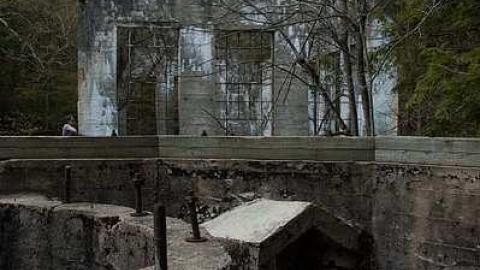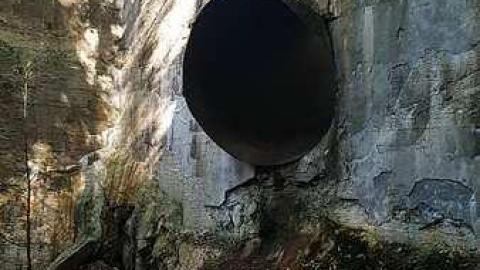About this location
Where the waters flow out of Little Meech Lake and over a waterfall into Meech Creek, Thomas Leopold 'Carbide' Willson built an experimental plant in 1911.
Willson was born in Princeton, Ontario in 1860. At a young age he demonstrated a knack for scientific ingenuity and curiosity that led him to develop many industrial processes. He obtained more than 70 patents in Canada and the United States.
Willson is most famous for his discovery of a process to produce calcium carbide through carbon electrolysis. In 1895 at the age of 35, Willson helped found a company that later became the multinational corporation Union Carbide. After inventing an electric arc furnace, Willson sought a use for it. He tried various materials, thinking he could produce aluminum in one instance and metallic calcium in another, both fails.
After combining coal tar and lime he found he had produced a strange gravely substance which bubbled when it became wet. Gas which was emitted from this process was flammable. It turned out that the gas was acetylene. In the days before electric light bulbs, people would use sooty coal lamps or candles. This new process was very much sought after for producing light and heat. This is how Willson became wealthy.
Like many other prominent Ottawa citizens of the time, he looked to the Gatineau Hills for a place to build a retreat. After purchasing 400 acres on the southeast shore of Meech Lake, in 1907 he built an opulent 'cottage' on the highest cliff overlooking the lake. The structure is built from materials from the site, including pink granite and timber, and blended in perfectly with it's surroundings. The two-and-a-half-storey house has 11 bedrooms, seven fireplaces and four chimneys. Surrounding the house are a garage, employee quarters, chapel and an aircraft hangar. Access to the property is via a massive gate of wrought iron and cut pink granite leading to a broad winding lane way lined with cut stone lamp posts. It is here that the Meech Lake Accord was negotiated in 1987.
Willson had turned his attention to fertilizer. In 1905 he began doing experiments in the basement laboratory of his Ottawa home, hoping to corner the world market on chemical fertilizer. Despite the sophistication of the lab, it didn't allow for sufficient volumes to be produced. He looked to his Meech Lake property as a place to continue his experiments. There was already a dam across Meech Creek from an old sawmill. Willson decided to build an entire industrial facility at this location. In 1911, he fortified the dam with over 1000 bags of cement and built an experimental power station and acid condensing tower. Before long local residents were up in arms over the fluctuating lake levels, which would rise and fall by a couple of meters as the needs of the power station dictated. Boathouses and docks would at one point be submerged, only to be found high and dry at other times. Being somewhat socially awkward and undeterred, Willson paid little attention to the rumblings. The electrical station provided enough power to supply his impressive phosphoric acid condenser which was the first of its kind in the world.
Willson was convinced that the plant would be a huge success and sank virtually everything he had into it, also taking out loans against his other patents with a single investor, American tobacco king J.B. Duke. When the time frame for production ran out, Willson was ruined and plunged into bankruptcy as Duke absorbed all his assets (except for some he had in Newfoundland dealing with hydroelectricity). He spent the last two years of his life trying to rebuild his life and the business in Newfoundland. He died in New York City in 1915 of a heart attack while trying to raise funds for a hydroelectric project in Labrador. Long after he died his dream was finally realized in 1974 as the Churchill Falls project.
The obsession that ruined him, then itself fell into ruins.
Albums 10
Carbide Willsons History
The ruins of Carbide Willson lab, where he conducted his research.
Wilson Caribe ruins
a historical site in the gatineau park https://ncc-ccn.gc.ca/places/carbide-willson-ruins































12 years ago
Great location